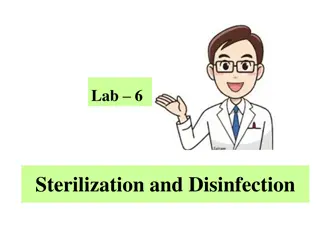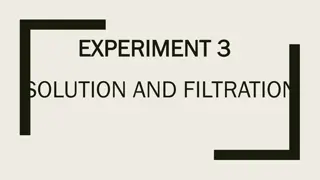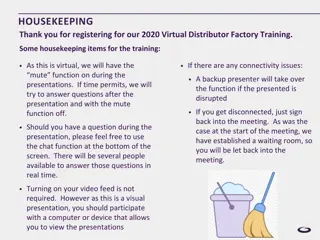Water Purification Methods and Techniques Explained
Explore the purification of water on both large and small scales, including storage, filtration, and disinfection processes. Learn about different methods such as boiling, chemical disinfection, and filtration for household water purification. Discover the importance of treatment based on the nature
4 views • 66 slides
Understanding Sterilization and Disinfection Methods in Laboratory Settings
Sterilization involves killing all microorganisms while disinfection targets pathogenic ones. Various methods like heat, filtration, radiation, and chemicals are used for effective sterilization. Physical sterilization through heat includes dry heat, direct flaming, hot air ovens, and incineration.
3 views • 21 slides
Regulation of Glomerular Filtration and GFR Physiology Overview
This detailed study delves into the regulation of glomerular filtration rate (GFR) in the kidneys. It covers the intrinsic and extrinsic mechanisms that control GFR, autoregulation, tubuloglomerular feedback, glomerular filtration membrane, filtration forces, molecular size and filterability of subs
8 views • 20 slides
Understanding Filtration Process in Industrial Operations
Filtration, a crucial unit operation, involves separating solids from liquids by passing them through a porous medium. This process is essential in industries like oil refining, beer production, and fruit juice processing. Filtration can be categorized into cake filtration, clarification, and cross-
6 views • 31 slides
Stainless Steel Water Filtration: Superior Water Quality with Green-Tak
Stainless Steel Water Filtration from Green-Tak offers ideal Point of Entry (POE) systems. This filtration solution purifies water before it reaches the pipelines. They are crafted with durable stainless-steel housing and a versatile filter cartridge, shielding household appliances such as washing m
6 views • 2 slides
Water Filtration & Bottles Stay Refreshed Anywhere, Water Filtration & Bottles
Stay Refreshed Anywhere, Water Filtration & Bottles\nSurvival Supplies Australia understands the importance of staying hydrated outdoors. When you're on the move, having a clean and fresh supply of drinking water is essential. Our range, including water filter bottles and portable water filters, ens
3 views • 1 slides
Understanding Downstream Processing in Bioprocessing
Downstream processing plays a crucial role in bioprocessing after fermentation, focusing on separating, purifying, and packaging the final product. It involves stages like cell disruption, removal of insoluble particles, product recovery, and purification methods such as filtration and centrifugatio
0 views • 38 slides
Understanding Mixtures and Separation Techniques
Explore the concepts of mixtures and separation, from the definition of dominant and recessive alleles to the advantages of electron microscopes. Learn about identifying pure substances, differences between pure and impure substances, and techniques like filtration and crystallization for separation
0 views • 19 slides
Residential RO System: Purified Water Everyday with Green-Tak
The Residential RO System from Green-Tak provides the purest water available with our customizable water filtration for your home, delivering pure, safe drinking water with up to 7 stages of advanced filtration. It pulls 90% of impurities, including
7 views • 7 slides
Key Steps in Downstream Processing: Recovery and Separation Techniques
The downstream recovery process involves five major stages: solid-liquid separation, release of intracellular products, concentration, purification by chromatography, and formulation. Solid-liquid separation methods include flotation, flocculation, and filtration using techniques like depth filters,
0 views • 33 slides
Understanding Solubility of Organic Compounds
A solution is a homogeneous mixture composed of a solute dissolved in a solvent. Solubility refers to the ability of one compound to dissolve in another. The solubility of organic compounds can be categorized based on chemical reactions like acid-base interactions. Different methods such as gravity
0 views • 6 slides
Milk Processing Methods and Pasteurization Overview by Dr. Sushma Kumari
Milk processing involves filtration, clarification, and standardization to adjust fat and SNF levels. Pasteurization methods such as Batch, HTST, Vacuum, Stassanization, UHT, and Uperization ensure milk safety. Dr. Sushma Kumari from Bihar Animal Sciences University provides detailed insights into m
0 views • 10 slides
Traditional Water Purification Techniques from Around the World
Traditional water treatment methods in various rural communities involve simple techniques such as filtration through winnowing sieves, cloth, clay vessels, and plant materials to remove visible impurities. These methods are used in places like Mali, India, Niger, and Egypt to filter out particles a
1 views • 8 slides
Respiratory Health Imaging Studies and Evaluation
Explore a series of informative images showcasing various respiratory health evaluations and studies, including mucociliary clearance, cough clearance measured by gamma scintigraphy, pulmonary deposition of inhaled aerosol therapies, and assessment of fitted filtration efficiency using specialized p
1 views • 5 slides
Separation and Purification of Organic Compounds: Methods and Techniques
The separation and purification of organic compounds are essential processes to obtain pure products, as impurities and side reactions can affect the quality of the compounds. Methods such as solution and filtration, crystallization, distillation, extraction, sublimation, and chromatography are comm
6 views • 15 slides
Understanding Capillary Circulation in the Vascular System
This content delves into the intricate components of capillary circulation, covering topics such as microcirculation, types of capillaries, regulation of flow in capillary beds, and the formation of interstitial fluid. It also discusses edema, lymphatics, diffusion, and filtration processes. The vis
4 views • 28 slides
Exploring Downstream Processing in Biotechnology for Product Recovery and Purification
Downstream processing in biotechnology involves the recovery and purification of biosynthetic products like pharmaceuticals from natural sources, using techniques such as filtration, centrifugation, and flocculation. This process is crucial in manufacturing antibiotics, hormones, antibodies, vaccine
1 views • 25 slides
Understanding Membrane Treatment in Water Filtration Systems
Membrane treatment plays a crucial role in water filtration systems by removing various contaminants such as turbidity, microbiology, and chemical impurities. This overview covers different types of membranes like plate and frame, spiral wound, tubular, and hollow fiber, highlighting their functions
0 views • 9 slides
Global PFAS Filtration Market
The Global PFAS Filtration Market Size is Anticipated to Exceed USD 3.7 Billion by 2033, Growing at a CAGR of 6.95% from 2023 to 2033.
0 views • 7 slides
Protein Desalting Techniques for Biochemical Purification
Protein desalting is crucial for purifying proteins after an ammonium sulfate precipitation step, which may leave the protein in a high-salt buffer. Three common desalting methods include dialysis using semi-permeable membranes, gel filtration with Sephadex G25 to exclude salts, and ultrafiltration
4 views • 6 slides
Controlling Microorganisms in Milk for Quality and Safety
Raw milk contains various microorganisms, and efficient cooling to 4°C post-milking is essential. Heat treatment methods like pasteurization, ultrapasteurization, and UHT processing help control bacterial numbers. Techniques such as centrifugation, filtration, and additional methods like carbon dio
0 views • 9 slides
Engineering a Hydrophilic Coating for Water Filtration Membranes
Explore the process of designing a model with hydrophilic polymers as antifouling coatings for water filtration membranes. Discover how these coatings resist fouling, ensuring clean water for consumption.
1 views • 12 slides
Understanding Filtration Mechanisms for Water Treatment
Filtration is a crucial process in water treatment where granular media remove solids through mechanisms like straining, sedimentation, impaction, and interception. Different types of filters, such as slow sand filters, rapid sand filters, and pressure filters, play vital roles in ensuring water qua
3 views • 10 slides
Understanding Filtration Mechanisms in Water Treatment
The filtration mechanism in water treatment involves various processes such as straining, sedimentation, impaction, and interception. Different types of filters like slow sand filters, rapid sand filters, and pressure filters play a crucial role in removing solids from water. Monitoring filtration i
1 views • 16 slides
Understanding Filtration: Process, Applications, and Mechanisms
Filtration is a process of separating solid particles or suspended matter from liquid or gas by passing it through a porous medium. This article discusses the definition of filtration, factors affecting its rate, applications in various industries, mechanisms involved, and different types of filtrat
1 views • 6 slides
Understanding Filtration in Sugar Processing
Filtration in sugar processing involves separating solid materials from liquids. The process is crucial for quality control and analysis. Different filter papers are used based on the substances to be removed. Proper folding of filter paper is essential for effective filtration. Understanding the pr
1 views • 20 slides
Virtual Distributor Factory Training 2020 Overview
Join the 2020 Virtual Distributor Factory Training for insights on filtration basics, unit of measure, Graver LPF product range, dead-end filtration, and the importance of liquid filtration. Stay engaged during the virtual training sessions with key details and visuals provided. Learn about differen
1 views • 47 slides
Titanium Filtration System Overview
A comprehensive overview of the Titanium Filtration System, highlighting its unique titanium membrane technology, benefits over traditional membranes, and comparison with traditional membranes in terms of temperature resistance, chemical and erosion resistance, service life, and more. The system fea
0 views • 10 slides
Understanding Filtration in Radiography
Filtration is a crucial process in radiography that involves eliminating undesirable low-energy photons to enhance image quality and reduce radiation dose to patients. This process involves using filters made of materials like aluminum to selectively absorb photons. Measurement of filtration is expr
0 views • 63 slides
Understanding X-Ray Filtration and Collimation in Dentistry
X-ray filtration and collimation play crucial roles in dentistry to enhance diagnostic radiology. Filtration removes long wave lengths, ensuring a beam consisting of high-energy, penetrating short wave lengths. Collimation controls the size and shape of the x-ray beam, reducing patient exposure and
0 views • 21 slides
Understanding Renal Clearance and its Physiological Mechanisms
This content delves into the concept of renal clearance, exploring its relation to lipophilicity and mechanisms such as glomerular filtration, tubular secretion, and reabsorption. The processes occurring at the nephron level and the vascularization scheme are detailed, along with a breakdown of phys
0 views • 31 slides
Gel Filtration Chromatography: Separation and Molecular Weight Determination
Gel filtration chromatography is a method used for separating proteins based on their molecular weights. This experiment aims to teach students the principles of gel filtration chromatography and provide hands-on experience in the lab. By utilizing a stationary phase of porous beads and a mobile pha
0 views • 22 slides
Understanding Gel Filtration Chromatography: Principles and Applications
Gel filtration chromatography is a molecular size-based separation technique used to separate macromolecules of different sizes. This method, also known as gel permeation or size exclusion chromatography, utilizes a porous stationary phase where small molecules penetrate all pores and are retained,
1 views • 10 slides
Techniques for Separating Mixtures: A GCSE Guide
Explore various separating techniques such as chromatography, distillation, filtration, and crystallization for different mixtures in a GCSE science context. Learn how to separate substances like solutes, solvents, liquids with similar boiling points, magnesium, salt, and more. Engage in a challengi
0 views • 5 slides
Understanding Mixtures: Homogeneous vs Heterogeneous and Separation Techniques
Explore the differences between homogeneous and heterogeneous mixtures, with examples like Cheerios and trail mix. Learn about mixtures like apple juice and orange juice with pulp. Discover how to separate mixtures based on their composition, whether they are homogeneous or heterogeneous, using tech
0 views • 16 slides
Membrane Filtration in Dairy Products: Utilization of Whey and Skim Milk
Utilizing membrane filtration in dairy processing transforms whey, a byproduct of cheese production, into valuable products like refined proteins. Ultrafiltration (UF) allows for the fractionation of whey into protein-rich and lactose-containing streams, increasing protein content significantly. The
0 views • 11 slides
Best Water Filtration Services in Bentley
If you want the Best Water Filtration Services in Bentley, visit Ace On Spades Plumbing. They are your local plumber with over 20 years of WA experience. From whole house water filtration to gas fitting, they have the skills and tools to get the job
1 views • 6 slides
Enhancing Bacteria Removal from Storm Water through Advanced Filtration Methods
In this term paper report, the focus is on maximizing the removal of bacteria, including pathogens like E. coli, from stormwater using sand media filters. The study reviews current research on sand media filters, compares different filter types, analyzes parameters affecting filter performance, and
0 views • 8 slides
Darcy's Law for Flow through Porous Medium and Water Filtration Device
Darcy's Law, first published in 1856, describes water flow through porous mediums, specifically sand layers. The law is applied to develop a new water filtration device for efficiently supplying water to a large city. Experimental demonstrations and tests conducted in 1855 support the relationship b
0 views • 4 slides
Interactive Model Demonstrating Kidney Function for Understanding Filtration and Selective Reabsorption
Explore the function of the kidney through a hands-on model activity involving blood components, filtration, selective reabsorption, and urine formation. This educational demonstration helps students grasp the processes involved in the kidney's role in maintaining homeostasis, including the impact o
0 views • 4 slides







































